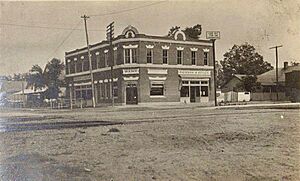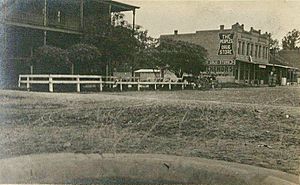Ponchatoula, Louisiana facts for kids
Quick facts for kids
Ponchatoula, Louisiana
|
|
|---|---|
| City of Ponchatoula | |
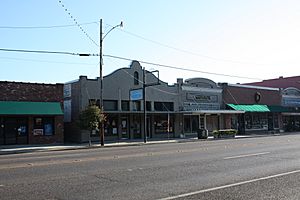
Downtown Ponchatoula
|
|
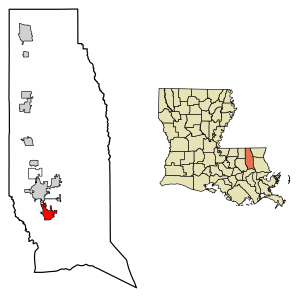
Location of Ponchatoula in Tangipahoa Parish, Louisiana.
|
|
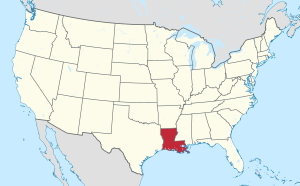
Location of Louisiana in the United States
|
|
| Country | United States |
| State | Louisiana |
| Parish | Tangipahoa |
| Area | |
| • Total | 4.74 sq mi (12.27 km2) |
| • Land | 4.73 sq mi (12.26 km2) |
| • Water | 0.00 sq mi (0.01 km2) |
| Elevation | 26 ft (8 m) |
| Population
(2020)
|
|
| • Total | 7,822 |
| • Density | 1,653.00/sq mi (638.20/km2) |
| Time zone | UTC−6 (CST) |
| • Summer (DST) | UTC−5 (CDT) |
| ZIP code |
70454
|
| Area code(s) | 985 |
| FIPS code | 22-61615 |
| GNIS feature ID | 2404548 |
| Website | City of Ponchatoula, Louisiana |
Ponchatoula is a city in Tangipahoa Parish, Louisiana, USA. It is the second-largest city in the parish. In 2020, about 7,822 people lived there.
Contents
What's in a Name? The Meaning of Ponchatoula
The name Ponchatoula comes from the Choctaw language. It is believed to mean "hanging hair." This name likely refers to the beautiful Spanish moss that hangs from trees in the area.
A Look Back: The History of Ponchatoula
Ponchatoula began in the 1850s. This was when a railroad was being built from Jackson, Mississippi, to New Orleans. A civil engineer named James B. Clarke helped plan the railroad. He found a good spot for a train station.
Mr. Clarke bought land near the station in 1852 and 1853. In 1853, he designed a town on this land. He named it "Ponchatoula" after a nearby river. The town grew quickly as people moved there to be near the railroad.
Ponchatoula During the Civil War
Ponchatoula became an official town in February 1861. Soon after, the American Civil War began. The town was important because of the railroad. This meant battles happened there in 1862 and 1863. Stores were robbed, homes were damaged, and the train station was burned.
Growth After the War
After the war, the railroad was fixed. A new train station was built. The town slowly grew. People worked in lumber and farming. Around 1900, growing strawberries became very popular. Ponchatoula became a major place for shipping strawberries. Hundreds of train cars full of strawberries left the town each spring.
Changes in the 20th Century
In 1921, two big lumber companies moved to Ponchatoula. Many workers and their families came to the town. This made the economy much stronger. New buildings were built, like a city hall, fire station, and high school. The town also got better services.
However, the good times ended with the Great Depression in 1929. The lumber mills closed. The strawberry industry helped the town during these hard times. One lumber company even reopened later.
Ponchatoula During World War II
During World War II, Ponchatoula helped the war effort. Many local men and women joined the armed forces. People held drives to collect scrap metal and sell war bonds. School children even helped collect a lot of iron for weapons.
The US Navy honored the town by naming an oil tanker the USS Ponchatoula. This ship served in the Pacific Ocean. Later, a new, larger oil tanker was also named the USS Ponchatoula.
After the war, Ponchatoula continued to grow. Its economy became more varied. It was no longer just about strawberries and lumber.
Ponchatoula Today: A Tourist Spot
Today, Ponchatoula is a popular place for tourists. It has a charming historic area. The town is even called "America's Antique City" because of its many antique shops. Every April, Ponchatoula hosts the famous Strawberry Festival. This event brings thousands of visitors to the town.
Where is Ponchatoula? Geography and Location
Ponchatoula is located about 26 feet (8 meters) above sea level. The city covers about 4.2 square miles (10.9 square kilometers) of land.
The city is located along Interstate 55 and Louisiana Highway 22. It is about the same distance from New Orleans and Baton Rouge. Long ago, Ponchatoula was one of only two ways to reach New Orleans by land. This earned it the nickname "Gateway to New Orleans."
Who Lives in Ponchatoula? Demographics
As of 2020, there were 7,822 people living in Ponchatoula. The city had 2,863 households.
| Race | Number | Percentage |
|---|---|---|
| White (non-Hispanic) | 4,799 | 61.35% |
| Black or African American (non-Hispanic) | 2,267 | 28.98% |
| Native American | 32 | 0.41% |
| Asian | 52 | 0.66% |
| Pacific Islander | 3 | 0.04% |
| Other/Mixed | 308 | 3.94% |
| Hispanic or Latino | 361 | 4.62% |
Learning in Ponchatoula: Education
The Tangipahoa Parish School System runs the public schools in the area. These include:
- Ponchatoula High School (near Ponchatoula)
- Ponchatoula Junior High School
- Martha Vineyard Elementary School (near Ponchatoula)
- D. C. Reeves Elementary School
- Tucker Elementary School
- Perrin Early Learning Center
Fun Things to Do: Visitor Attractions
Ponchatoula is known for its annual events and unique spots.
- The Strawberry Festival is held every April.
- An Oktoberfest celebration takes place each autumn.
- Many antique shops can be found along Pine Street (LA 22).
- Eleven buildings in the Ponchatoula Commercial Historic District are historically important. They are listed on the National Register of Historic Places.
- The Collinswood School Museum is a former one-room schoolhouse. It shows local artifacts and quilts.
- The Strawberry Train is a steam engine and passenger car. Kids can safely climb inside.
- The Chamber of Commerce office has information about these and other local sights.
The Famous Strawberry Festival
The first Strawberry Festival was held in April 1972. It was a small, two-day event with only 11 booths. Today, it is the second-largest event in Louisiana. Only Mardi Gras is bigger.
In the 1980s, the town's economy changed. Farming was not enough to support the town. The mayor had an idea to open antique shops in old business buildings. This helped the town become "America's Antique City."
Famous People from Ponchatoula
Many notable people have come from Ponchatoula, including:
- Irwin Davis, a football player, coach, and administrator
- Michael I. Jordan, a researcher in Machine Learning and Artificial Intelligence
- Steve Pugh, a politician who served in the Louisiana House of Representatives
- Trevante Rhodes, an actor and sprinter
- Bernie Smith, a baseball player
- Tyjae Spears, a football player
- Irma Thomas, a famous singer
- Reggie Walker, a football player
- Earl Wilson, a baseball player
See also
 In Spanish: Ponchatoula para niños
In Spanish: Ponchatoula para niños


